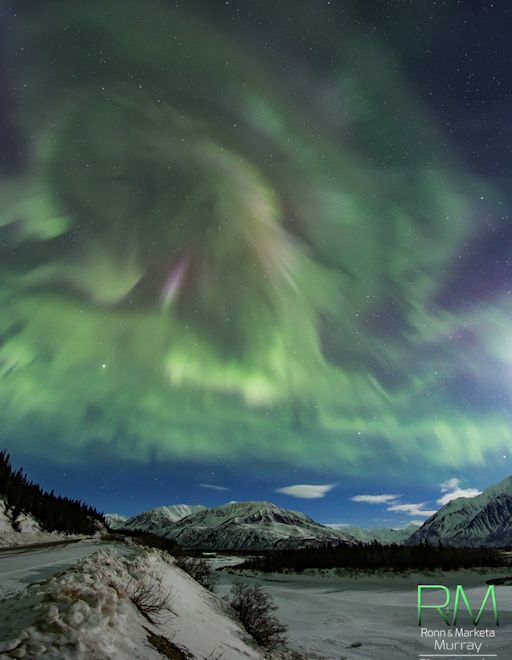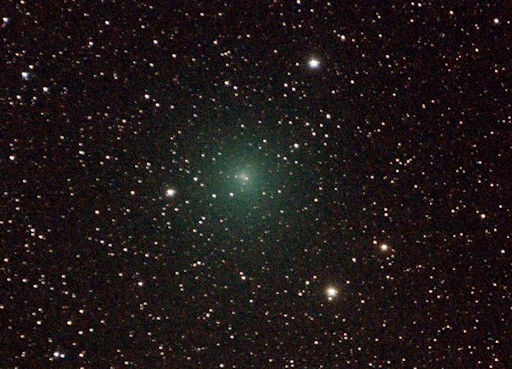Marianne's Heaven On Earth Aurora Chaser Tours Chasethelighttours.co.uk invites you to join them in their quest to find and photograph the Aurora Borealis. Experience the winter wonderland in the Tromsø Area. | | | MINOR ERUPTION, BEAUTIFUL MOVIE: A magnetic filament attached to sunspot AR2522 erupted during the early hours of March 16th. Although the eruption was relatively minor, it made a beautiful movie (credit: NASA/SDO). Energetic protons streaming past Earth are slightly elevated as a result of the blast. Solar flare alerts: text or voice SOLAR WIND SPARKS AURORAS: Earth is passing through a stream of solar wind, and the encounter is sparking bright auroras around the Arctic Circle. Last night, aurora tour guide Marketa S. Murray photographed the display from the countryside near Fairbanks, Alaska 
"There was so much energy, the whole sky was pulsating with aurora," says Murray. "It was an amazing night." Tonight could be the same. Magnetic fields in this solar wind stream have a negative polarity. This means they can link to Earth's magnetic field, opening a crack in our planet's magnetosphere and allowing solar wind inside. Auroras will likely follow. NOAA forecasters estimate a 60% chance of G1-class geomagnetic storms on March 16th. Aurora alerts: text or voice Realtime Aurora Photo Gallery COMET BRIGHTENS AS IT APPROACHES EARTH: On March 21st, Comet 252P/LINEAR will make a close approach to Earth--only 0.036 AU (5.4 million km) away. This is the fifth closest cometary approach on record and, as a result, the normally dim comet could become an easy target for backyard telescopes. In fact, it is brightening much faster than expected: data. "Comet 252P/LINEAR has surpassed expectations and is now bordering on naked eye visibility for southern observers," reports Michael Mattiazzo of Swan Hill, Victoria, Australia, who took this picture on March 13th: 
"Since March 7th, the comet has brightened about 0.5 magnitudes per day," continues Mattiazzo, "and now it is near 6th magnitude. The comet's atmosphere (coma) is expanding rapidly, too, from 10 arcminutes on March 7th to 35 arcminutes on March 14th. It may reach 1o across by March 21st." This is a southern hemisphere event. At closest approach on March 21st, the brightening comet will speed through the constellations Triangulum Australis and Apus. Observers south of the equator can use this ephemeris to point their telescopes. In remote places with very dark skies, it is possible that no telescope will be required; naked eyes might suffice. UPDATE: There is a chance that the comet's approach could cause a minor meteor shower. According to the International Meteor Organization, modeling by meteor forecaster "Mikhail Maslov indicates that there might be a weak episode of faint, very slow meteors (15.5 km/s) on March 28–30 from a radiant near the star μ Leporis." Little is known about meteors from this comet, so estimates of the meteor rate are very uncertain. Maslov's models suggest no more than 5 to 10 per hour. Realtime Comet Photo Gallery A SPHERICAL VIEW OF THE SOLAR ECLIPSE: One week ago, the students of Earth to Sky Calculus stood on a beach in Indonesia waiting for the cool shadow of the Moon to sweep over the white sands of Belitung Island. They were there to test cameras for high-altitude ballooning--specifically, the Solar Eclipse Balloon Network. One of those cameras was a Ricoh spherical camera--able to see in all directions at once. Such a camera can take interactive 360o images, like this one of the students setting up their experiment on the beach: On the beach at Belitung Island, Indonesia. - Spherical Image - RICOH THETA We already know that this camera can operate at the edge of space. It traveled there in late February and took spectacular pictures of the stratosphere. But could it photograph a total eclipse of the sun? The answer is "yes." Minutes after the first picture was taken, the shadow of the Moon engulfed Belitung Island, and the Ricoh did a great job capturing the alien twilight. Click here to transport yourself to the path of totality. This spherical camera will travel back to the edge of space next week as the space weather ballooning program continues. Stay tuned for more 360o images. March 9th Solar Eclipse Photo Gallery
Realtime Spaceweather Photo Gallery
Every night, a network of NASA all-sky cameras scans the skies above the United States for meteoritic fireballs. Automated software maintained by NASA's Meteoroid Environment Office calculates their orbits, velocity, penetration depth in Earth's atmosphere and many other characteristics. Daily results are presented here on Spaceweather.com. On Mar. 16, 2016, the network reported 7 fireballs.
(7 sporadics)  In this diagram of the inner solar system, all of the fireball orbits intersect at a single point--Earth. The orbits are color-coded by velocity, from slow (red) to fast (blue). [Larger image] [movies] Potentially Hazardous Asteroids ( PHAs) are space rocks larger than approximately 100m that can come closer to Earth than 0.05 AU. None of the known PHAs is on a collision course with our planet, although astronomers are finding new ones all the time. On March 16, 2016 there were potentially hazardous asteroids.  | Notes: LD means "Lunar Distance." 1 LD = 384,401 km, the distance between Earth and the Moon. 1 LD also equals 0.00256 AU. MAG is the visual magnitude of the asteroid on the date of closest approach. | | Cosmic Rays in the Atmosphere | | Situation Report -- Oct. 30, 2015 | Stratospheric Radiation (+37o N) | | Cosmic ray levels are elevated (+6.1% above the Space Age median). The trend is flat. Cosmic ray levels have increased +0% in the past month. | | Sept. 06: 4.14 uSv/hr (414 uRad/hr) | | Sept. 12: 4.09 uSv/hr (409 uRad/hr) | | Sept. 23: 4.12 uSv/hr (412 uRad/hr) | | Sept. 25: 4.16 uSv/hr (416 uRad/hr) | | Sept. 27: 4.13 uSv/hr (413 uRad/hr) | | Oct. 11: 4.02 uSv/hr (402 uRad/hr) | | Oct. 22: 4.11 uSv/hr (411 uRad/hr) | These measurements are based on regular space weather balloon flights: learn more. Approximately once a week, Spaceweather.com and the students of Earth to Sky Calculus fly "space weather balloons" to the stratosphere over California. These balloons are equipped with radiation sensors that detect cosmic rays, a surprisingly "down to Earth" form of space weather. Cosmic rays can seed clouds, trigger lightning, and penetrate commercial airplanes. Our measurements show that someone flying back and forth across the continental USA, just once, can absorb as much ionizing radiation as 2 to 5 dental X-rays. For example, here is the data from a flight on Oct. 22, 2015: 
Radiation levels peak at the entrance to the stratosphere in a broad region called the "Pfotzer Maximum." This peak is named after physicist George Pfotzer who discovered it using balloons and Geiger tubes in the 1930s. Radiation levels there are more than 80x sea level. Note that the bottom of the Pfotzer Maximim is near 55,000 ft. This means that some high-flying aircraft are not far from the zone of maximum radiation. Indeed, according to the Oct 22th measurements, a plane flying at 45,000 feet is exposed to 2.79 uSv/hr. At that rate, a passenger would absorb about one dental X-ray's worth of radiation in about 5 hours. The radiation sensors onboard our helium balloons detect X-rays and gamma-rays in the energy range 10 keV to 20 MeV. These energies span the range of medical X-ray machines and airport security scanners. | | The official U.S. government space weather bureau | | | The first place to look for information about sundogs, pillars, rainbows and related phenomena. | | | Researchers call it a "Hubble for the sun." SDO is the most advanced solar observatory ever. | | | 3D views of the sun from NASA's Solar and Terrestrial Relations Observatory | | | Realtime and archival images of the Sun from SOHO. | | | from the NOAA Space Environment Center | | | the underlying science of space weather | | 
